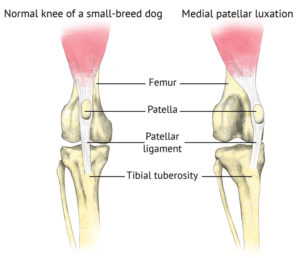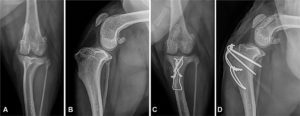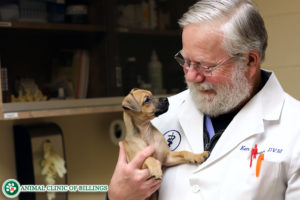Canine rehabilitation after luxating patella surgery
Canine Rehabilitation after Luxating Patella Surgery
 It is imperative that all exercise restrictions are strictly adhered to. These restrictions are designed to minimize the strain that your pet places on the surgery site and thereby decrease post surgical complications.
It is imperative that all exercise restrictions are strictly adhered to. These restrictions are designed to minimize the strain that your pet places on the surgery site and thereby decrease post surgical complications.
 Rehabilitation is also recommended to help your pet return to his/her normal self. “Rehab” promotes a more rapid return to normal function by maintaining normal range of motion in the joints, by maintaining or increasing muscle development, and by improving balance and co-ordination. The Rehab program outlined below has been developed specifically for your pets post surgical recovery period. Rehab will help speed up recovery and increase the likelihood of an excellent outcome. It is very important that for you to contact the if you have any concerns regarding the program or exercises outlined below. It is also extremely important that these exercises are performed in a manner that is not painful for your dog or dangerous for you to perform. Never force any therapy. If your pet seems excessively painful during any of the exercises please stop them and contact the hospital for further instructions.
Rehabilitation is also recommended to help your pet return to his/her normal self. “Rehab” promotes a more rapid return to normal function by maintaining normal range of motion in the joints, by maintaining or increasing muscle development, and by improving balance and co-ordination. The Rehab program outlined below has been developed specifically for your pets post surgical recovery period. Rehab will help speed up recovery and increase the likelihood of an excellent outcome. It is very important that for you to contact the if you have any concerns regarding the program or exercises outlined below. It is also extremely important that these exercises are performed in a manner that is not painful for your dog or dangerous for you to perform. Never force any therapy. If your pet seems excessively painful during any of the exercises please stop them and contact the hospital for further instructions.
From hospital discharge – until the first recheck
- Gently Massage the quadriceps and hamstring muscles (large muscle groups at the front and back of the thigh respectively). It is best to massage for 2-3 minutes before and after PROM. Massaging will help stimulate blood and lymphatic flow and break down scar tissue within the muscles. Start by applying light pressure and gradually increase it over the course of the massage. Try to keep a steady rhythm. Start close to the toes and move up the muscle towards the hip (be very gentle around the surgery site (under the incision line) as excessive pressure in this area could result in unnecessary discomfort)
- Passive Range of Motion (PROM): this activity involves moving all joints of the limb through a comfortable range of motion. This will promote cartilage and joint health, prevent contraction of the muscle and stimulate blood and lymphatic flow. If your pet is reluctant to cooperate, consider muzzling your pet to protect yourself and get the work done efficiently and safely. Have them lie on their side with the affected limb up. Gently and slowly extend and flex each joint (ankle, knee, and hip) 10 times, for 2-3 sessions daily. This should not be an unpleasant exercise and should only take 2 to 5 minutes.
- Assist your pet over slippery surfaces or up stairs by carrying or slinging them this will be necessary for the next 8 weeks)
- Short, slow, controlled short-leash walks are good. Start with 5-10 minute walks 2-3 times daily.
- After the above exercises are completed apply a cool compress to the hip (over the knee incision) 3-4 times per day for 5 to 10 minutes for the first 7 days. This will help decrease swelling and discomfort (a bag of frozen peas wrapped in a towel works well).
- Typically after the first week the vast majority of swelling has dissipated and cold compresses can be stopped (if excessive swelling is still noted 1 week post surgery please contact the hospital for further instructions) and moist heat therapy initiated. For heat therapy, a commercial heat product is advised. Moist heat has been shown to penetrate better than dry heat. A number of different moist heat products are available at most drug stores and typically contain gel, beads, rice etc. Another way to provide moist heat is to take a washcloth and wet it with warm water. Regardless of the product used it is imperative that it be warm to the touch but not so hot that it is painful when applied to your own wrist. If excessively hot it could result in a thermal burn. This therapy should be performed for 5 to 10 minutes prior to the above exercise sessions.
Weeks 2-4
- Continue with PROM
- Continue with massages
- Increase walks to 10-15 minute walks 2-4 times daily. You are still keeping them slow, controlled and on a short-leash.
- Sit-Stand-Sit exercises. We call these puppy squats. The goal is to have your dog to sit down and immediately stand back up (small treats help tremendously- watch the calories if your dog is overweight). This promotes extension and flexion of all of the joints of the hind leg and also works all the muscles surrounding the knee. This should be performed 3 to 4 times daily and consist of 5 to 7 repetitions.
- Figure Eights To perform this exercise effectively, imagine a large figure 8 on the ground with each circle approximately 10 to 15 feet in diameter (if your dog is having difficulty navigating enlarge the size of the figure 8). Walk your dog around the figure 8 at a very slow speed. This exercise should be performed 3 to 4 times daily and each session consists of ten repetitions. As your dog becomes more adept at performing this exercise the size of the circles can be decreased to 4 to 5 feet in diameter.
- Continue with moist heat after the above activities.
Weeks 4-6
- Continue with massage and PROM exercises if needed or found to be beneficial. Otherwise discontinue.
- Increase walks to 15-20 minute leash walks 3 times daily.
- Continue Sit-Stand-Sit exercises.
- Continue Figure Eights
Weeks 6-8
- Increase walks to 20-30 minute leash walks 3 times daily. (if possible in an area where short hills are present- see “Slow Controlled Hill Walks” below.
- Continue with Sit-Stand-Sit exercises. Should be increased to ten to twenty repetitions 3 to 4 times daily.
- Continue witNovember 21, 2018h Figure Eights. Increase to ten to twenty repetitions 3 to 4 times daily.
- Controlled stairs, (i.e.- holding your pet’s collar) may be performed at this time if your pet seems up to it. There should be no free access to stairs until permission has been given- typically at the 8 week recheck. Do 5 to 15 stairs (typically one flight) in a row 1 to 3 times daily. If stairs are not present in your home you may take your dog to an outdoor area where stairs are present or just skip this exercise.
- Slow Controlled Hill Walks. Use a hill that you can comfortably walk on (not too steep). This exercise involves walking your dog SLOWLY up, down and across the hill with the surgery leg on the down-slope side while on a short (2 to 3 foot) leash. This exercise increases strength and muscle mass of the surgery leg, promotes better balance and improves the range of motion of the knee joint. This exercise should be reserved for after his/her leash walk since your pet will typically be a little calmer and more manageable at this time.
If all is going well at the eight week recheck exercise restrictions are typically lifted with the exception of high impact activities involving ball and frisbee play, rough-housing with other dogs and off leash activities outside of the backyard. Typically all restrictions are lifted by 10 to 12 weeks post surgery.
Thank you for allowing us to share in the treatment of your dear family member.

Let our highly trained and experienced team of veterinarians and veterinary technicians help you keep your cat as happy and healthy as they can be.
Call the Animal Clinic of Billings and Animal Surgery Clinic to schedule your pet cat’s next wellness examination with one of our veterinarians today!
406-252-9499 REQUEST AN APPOINTMENT



